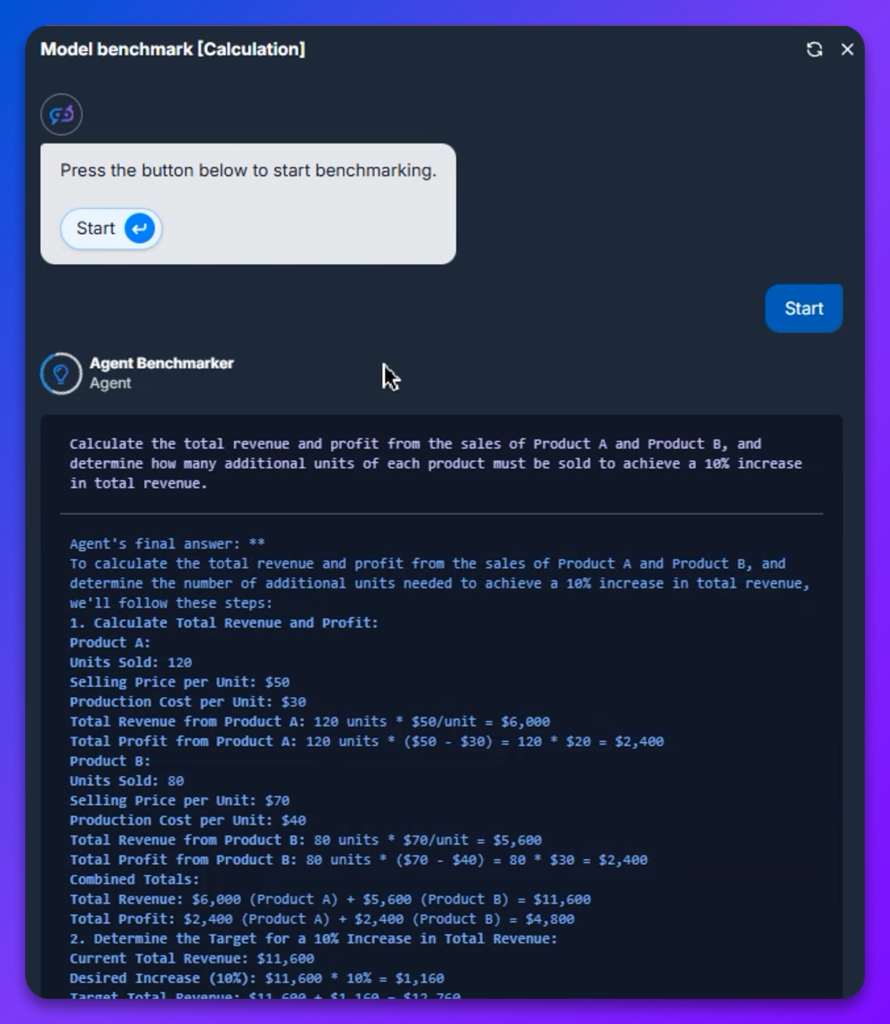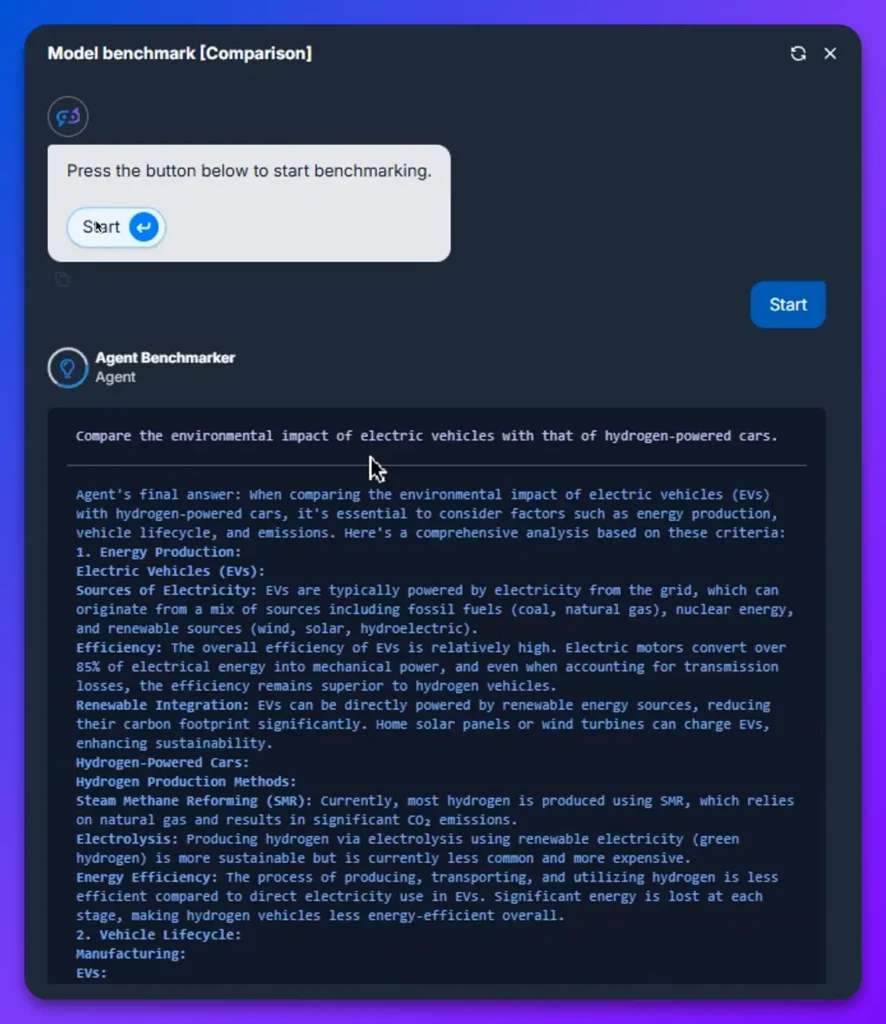
AI 에이전트 이해하기: GPT 4o Mini의 사고방식
GPT-4o Mini AI 에이전트의 고급 기능을 탐구하세요. 이 심층 분석에서는 텍스트 생성 그 이상을 넘어선 추론, 문제 해결, 창의적 역량을 다양한 작업을 통해 보여줍니다....

GPT-o1 Mini와 유사한 AI 에이전트가 실제 작업을 통해 어떻게 ‘사고’하고, 추론하며, 문제를 해결하고, 창작하는지 알아보며, 그 구조화된 접근 방식과 다양한 역량을 확인하세요.
Prompt:
When user says “Start” you should:
The specific task labeled as ‘Start’ involves creating a comprehensive and informative article on the fundamentals of project management. This task requires a detailed focus on defining objectives, establishing the scope of the project, and effective delegation of tasks.
Detailed Context and Criteria:
Defining Objectives:
- Purpose: Clearly articulate the primary goals of the project.
- SMART Goals: Ensure objectives are Specific, Measurable, Achievable, Relevant, and Time-bound.
- Alignment: Objectives should align with the overall mission and vision of the organization.
- Clarity: Objectives must be communicated in an understandable manner to all stakeholders.
Time Taken: 41 seconds
Readability:
Summary Length: 330 words
Prompt:
A company sells two products: Product A and Product B. Product A costs $30 per unit to produce and sells for $50 per unit. Product B costs $40 per unit to produce and sells for $70 per unit.
The company sold 120 units of Product A and 80 units of Product B last month.
Calculate the total revenue generated from the sales of both products.
Calculate the total profit generated from the sales of both products (Revenue – Total production cost).
The company wants to increase the total revenue by 10%. How many additional units of each product must they sell to achieve this goal, assuming the production cost per unit and selling price per unit remain constant?
1. Total Revenue and Profit:
Product A:
- Units Sold: 120
- Selling Price per Unit: $50
- Production Cost per Unit: $30
- Total Revenue from Product A: $6,000
- Total Profit from Product A: $2,400
Product B:
- Units Sold: 80
- Selling Price per Unit: $70
- Production Cost per Unit: $40
- Total Revenue from Product B: $5,600
- Total Profit from Product B: $2,400
Combined Totals:
- Total Revenue: $11,600
- Total Profit: $4,800
Time Taken: 41 seconds
Readability:
Summary Length: 375 words
Prompt:
Summarize the key findings from the previous article in 100 words, focusing on the most significant sections.
The article explores AI reasoning, distinguishing between formal logic-based methods and natural language processing approaches. It underscores AI reasoning’s critical role in decision-making, problem-solving, and enhancing human-AI interactions. Historical milestones include early AI systems, development of expert systems, advancement of neural networks, and the emergence of modern models like GPT. Applications in healthcare demonstrate AI’s potential in diagnostics and treatment planning, while implications extend across various industries. Challenges such as over-specialization and ethical concerns, including bias and accountability, are addressed. The article highlights recent progress with OpenAI’s o1 model, emphasizing its advanced features and superior performance in STEM benchmarks, marking significant strides in AI reasoning capabilities.
Time Taken: 24 seconds
Readability:
Summary Length: 108 words
Prompt:
When user says “Start” you should:
Compare the environmental impact of electric vehicles with that of hydrogen-powered cars. Include factors such as energy production, vehicle lifecycle, and emissions.
When comparing the environmental impact of electric vehicles (EVs) with hydrogen-powered cars, it’s essential to consider factors such as energy production, vehicle lifecycle, and emissions. Here’s a comprehensive analysis based on these criteria:
1. Energy Production:
- Electric Vehicles (EVs):
- Sources: Grid electricity (fossil, nuclear, renewables).
- Efficiency: Electric motors >85% efficient; overall superior to hydrogen.
- Renewables: Direct charging from solar/wind reduces footprint.
- Hydrogen-Powered Cars:
- SMR: Most hydrogen is produced from natural gas (CO₂ emissions).
- Electrolysis: Cleaner with renewables but less common and costlier.
- Energy losses: Production/transport/utilization less efficient than EVs.
Time Taken: 40 seconds
Readability:
Summary Length: 662 words
Prompt:
Write a futuristic story (500 words) set in a world where electric vehicles have fully replaced traditional combustion-engine vehicles. Describe the environmental changes and societal impact.
In the year 2050, the once-bustling streets of Metropolis had transformed into serene boulevards of silence and efficiency. Electric vehicles (EVs) had fully eclipsed their combustion-engine predecessors, marking a pivotal shift in the city’s landscape and its inhabitants’ lives.
The air was noticeably cleaner. Without the incessant hum and exhaust fumes of gasoline engines, the skyline was clearer, allowing sunsets to paint the horizon with vibrant hues of orange and pink each evening. Trees thrived in this less polluted environment, their leaves greener and more abundant, providing shade and oxygen in equal measure. The reduction in airborne pollutants led to a significant decline in respiratory illnesses, and hospitals reported a decrease in asthma and other pollution-related conditions.
Noise pollution had become a relic of the past. The streets, once echoing with the roar of engines, were now dominated by the soft whirring of electric motors and the occasional hum of charging stations. This newfound tranquility fostered a sense of calm and well-being among the city’s residents. Public parks flourished as quiet spaces for relaxation and community gatherings, free from the constant drone of traffic.
Time Taken: 43 seconds
Readability:
Summary Length: 594 words
Our exploration through these five diverse tasks provides a fascinating glimpse into the advanced capabilities of AI agents, exemplified by the hypothetical “GPT-4o Mini.” From crafting detailed articles on complex topics like project management and environmental impact, to calculations, summarization, comparison, and storytelling, the agent demonstrates proficiency beyond traditional language models.
With continued evolution, AI agents will offer even more advanced reasoning, problem-solving, and creativity. Their integration will expand from professional tasks to everyday life, serving as invaluable tools for innovation. The GPT-4o Mini, though hypothetical here, previews real capabilities arriving soon. Insights from these analyses offer a roadmap for future AI development and deployment.
GPT-o1 Mini는 컴팩트한 크기와 효율성이 돋보이며, 고도화된 자연어 이해, 추론, 복합 문제 해결 능력을 매우 최적화된 형태로 제공합니다.
이들은 구조화된 단계별 과정을 사용합니다: 작업 분해, 요구사항 분석, 논리적 추론 적용, 결과의 정확성과 완전성 평가 등입니다.
네, 본문에서는 GPT-o1 Mini가 계산, 콘텐츠 생성, 요약, 비교, 창의적 이야기 만들기 등에서 뛰어난 성과를 보임을 시연합니다.
아닙니다. 최신 AI 에이전트는 추론, 데이터 분석, 정보 종합, 계산 수행, 창의성 발휘 등 단순 텍스트 출력 그 이상으로 가치가 있습니다.
GPT-4o Mini AI 에이전트의 고급 기능을 탐구하세요. 이 심층 분석에서는 텍스트 생성 그 이상을 넘어선 추론, 문제 해결, 창의적 역량을 다양한 작업을 통해 보여줍니다....
Grok Beta AI 에이전트가 보여주는 추론, 문제 해결, 창의적 작업의 고급 능력을 탐구합니다. 이 심층 분석에서는 실습 분석을 통해 강점, 한계, 실제 활용 사례를 밝혀냅니다....
Claude 3.5 Sonnet이 AI 에이전트로서 지닌 고급 역량을 탐구하세요. 이 심층 분석에서는 텍스트 생성 그 이상을 넘어선 추론, 문제 해결, 창의적 기술을 다양한 작업을 통해 보여줍니다....



